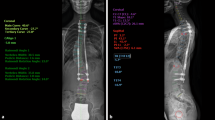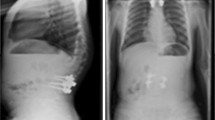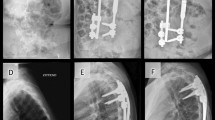Abstract
Purpose
The importance of sagittal alignment restoration in early onset scoliosis (EOS) management has rarely been investigated to date. The aim was to report the influence of magnetically controlled growing rods (MCGR) insertion on the sagittal alignment of EOS patients.
Methods
All consecutive ambulatory patients operated with MCGR rods between 2011 and 2018 were retrospectively included in four institutions. Standing biplanar radiographs were performed preoperatively, in the early postoperative period and at latest follow-up. Global and local sagittal parameters, spinal global shape and harmony were investigated.
Results
A total of 37 ambulatory EOS patients were included (mean age at surgery 8.5 (± 2) years). 70% had a balanced construct postoperatively. Both MaxTK (− 17°, p = 0.02) and MaxLL (− 15°, p = 0.001) were significantly reduced, particularly at the instrumented levels. The number of vertebrae included in the lumbar lordosis significantly increased (+ 2 levels, p = 0.02), as well as the thoraco-lumbar inflexion point (+ 2 levels, p < 0.001) and the kyphosis apex (+ 1 level, p < 0.001). Overall mechanical failure rate was 40.5%, and radiological PJK was observed in 43% of the patients, with 11 remaining asymptomatic. Patients with initial hyperkyphosis (> 50°) developed more complications (62% vs. 28%, p = 0.04).
Conclusion
MCGR insertion flattened the spine in EOS, at both instrumented and non-instrumented levels. Overall spinal harmony was modified, with a cranial shift of the thoraco-lumbar inflexion point and the thoracic kyphosis apex, associated with a lengthening of the lumbar lordosis. The rate of complication remained high, some explanations being found in the radiological changes reported such as the preoperative location of the TK apex.
Level of evidence
IV.





Similar content being viewed by others
Availability of data and materials
The datasets generated during and/or analyzed during the current study are available from the corresponding author on reasonable request.
References
Karol LA (2019) The natural history of early-onset scoliosis. J Pediatr Orthop 39 (Issue 6, Supplement 1 Suppl 1): S38‑43
Akbarnia BA, Pawelek JB, Cheung KMC, Demirkiran G, Elsebaie H, Emans JB et al (2014) Traditional growing rods versus magnetically controlled growing rods for the surgical treatment of early-onset scoliosis: a case-matched 2-year study. Spine Deform 2(6):493–497
Sankar WN, Acevedo DC, Skaggs DL (2010) Comparison of complications among growing spinal implants. Spine 35(23):2091–2096
Shah SA, Karatas AF, Dhawale AA, Dede O, Mundis GM, Holmes L et al (2014) The effect of serial growing rod lengthening on the sagittal profile and pelvic parameters in early-onset scoliosis. Spine 39(22):E1311-1317
Watanabe K, Uno K, Suzuki T, Kawakami N, Tsuji T, Yanagida H et al (2016) Risk factors for proximal junctional kyphosis associated with dual-rod growing-rod surgery for early-onset scoliosis. Clin Spine Surg 29(8):E428-433
Atici Y, Akman YE, Erdogan S, Sari S, Yavuz U, Carkci E et al (2015) The effect of growing rod lengthening technique on the sagittal spinal and the spinopelvic parameters. Eur Spine J 24(6):1148–1157
Pan A, Hai Y, Yang J, Zhang Y, Zhang Y (2018) Upper instrumented vertebrae distal to T2 leads to a higher incidence of proximal junctional kyphosis during growing-rod treatment for early onset scoliosis. Clin Spine Surg 31(7):E337–E341
Polly DW, Ackerman SJ, Schneider K, Pawelek JB, Akbarnia BA (2016) Cost analysis of magnetically controlled growing rods compared with traditional growing rods for early-onset scoliosis in the US: an integrated health care delivery system perspective. Clinicoecon Outcomes Res 8:457–465
Aslan C, Olgun ZD, Ayik G, Karaokur R, Ozusta S, Demirkiran GH et al (2019) Does decreased surgical stress really improve the psychosocial health of early-onset scoliosis patients? A comparison of traditional growing rods and magnetically-controlled growing rods patients reveals disappointing results. Spine 44(11):E656–E663
Thakar C, Kieser DC, Mardare M, Haleem S, Fairbank J, Nnadi C (2018) Systematic review of the complications associated with magnetically controlled growing rods for the treatment of early onset scoliosis. Eur Spine J 27(9):2062–2071
Ilharreborde B (2018) Sagittal balance and idiopathic scoliosis: does final sagittal alignment influence outcomes, degeneration rate or failure rate? Eur Spine J 27(Suppl 1):48–58
Akbarnia BA, Cheung K, Noordeen H, Elsebaie H, Yazici M, Dannawi Z et al (2013) Next generation of growth-sparing techniques: preliminary clinical results of a magnetically controlled growing rod in 14 patients with early-onset scoliosis. Spine 38(8):665–670
Williams BA, Matsumoto H, McCalla DJ, Akbarnia BA, Blakemore LC, Betz RR et al (2014) Development and initial validation of the Classification of Early-Onset Scoliosis (C-EOS). J Bone Jt Surg Am 96(16):1359–1367
Maillot C, Ferrero E, Fort D, Heyberger C, Le Huec J-C (2015) Reproducibility and repeatability of a new computerized software for sagittal spinopelvic and scoliosis curvature radiologic measurements : Keops (®). Eur Spine J 24(7):1574–1581
Gutman G, Labelle H, Barchi S, Roussouly P, Berthonnaud É, Mac-Thiong J-M (2016) Normal sagittal parameters of global spinal balance in children and adolescents: a prospective study of 646 asymptomatic subjects. Eur Spine J 25(11):3650–3657
Mangione P, Gomez D, Senegas J (1997) Study of the course of the incidence angle during growth. Eur Spine J 6(3):163–167
Schroerlucke SR, Akbarnia BA, Pawelek JB, Salari P, Mundis GM, Yazici M et al (2012) How does thoracic kyphosis affect patient outcomes in growing rod surgery? Spine 37(15):1303–1309
Chen Z, Qiu Y, Zhu Z, Li S, Chen X, Sun X (2017) How does hyperkyphotic early-onset scoliosis respond to growing rod treatment? J Pediatr Orthop 37(8):e593–e598
Mazda K, Ilharreborde B, Even J, Lefevre Y, Fitoussi F, Penneçot GF (2009) Efficacy and safety of posteromedial translation for correction of thoracic curves in adolescent idiopathic scoliosis using a new connection to the spine: the universal clamp. Eur Spine J 18(2):158–169
Bekmez S, Demirkiran HG, Dede O, Atici Y, Balioglu MB, Kruyt M, Ward T, Yazici M (2019) Spinal instrumentation in growing children retards the natural development of pelvic incidence. J Pediatr Orthop 39(3):141–145
Inaparthy P, Queruz JC, Bhagawati D, Thakar C, Subramanian T, Nnadi C (2016) Incidence of proximal junctional kyphosis with magnetic expansion control rods in early onset scoliosis. Eur Spine J 25(10):3308–3315
Erdoğan S, Polat B, Atıcı Y, Özyalvaç ON, Öztürk Ç (2019) Comparison of the effects of magnetically controlled growing rod and traditional growing rod techniques on the sagittal plane in the treatment of early-onset scoliosis. J Korean Neurosurg Soc 62(5):577–585
Akbarnia BA, Marks DS, Boachie-Adjei O, Thompson AG, Asher MA (2005) Dual growing rod technique for the treatment of progressive early-onset scoliosis: a multicenter study. Spine 30(17 Suppl):S46-57
Li WJ, Sun ZJ, Guo SG, Qiu GX, Zhang JG, Shen JX, Wang YP, Zhao H, Li SG, Zhao Y (2016) The effect of growing Rod treatment on coronal balance during serial lengthening surgeries in early onset scoliosis. BMC Musculoskelet Disord 12(17):158
Carender CN, Morris WZ, Poe-Kochert C, Thompson GH, Son-Hing JP, Liu RW (2016) Low pelvic incidence is associated with proximal junctional kyphosis in patients treated with growing rods. Spine 41(9):792–797
Kwan KYH, Alanay A, Yazici M, Demirkiran G, Helenius I, Nnadi C et al (2017) Unplanned reoperations in magnetically controlled growing rod surgery for early onset scoliosis with a minimum of two-year follow-up. Spine 42(24):E1410–E1414
Choi E, Yaszay B, Mundis G et al (2017) Implant complications after magnetically controlled growing rods for early onset scoliosis: a multicenter retrospective review. J Pediatr Orthop 37(8):e588–e592
Lonner BS, Ren Y, Newton PO, Shah SA, Samdani AF, Shufflebarger HL, Asghar J, Sponseller P, Betz RR, Yaszay B (2017) Risk factors of proximal junctional kyphosis in adolescent idiopathic scoliosis-the pelvis and other considerations. Spine Deform 5(3):181–188
Funding
None of the authors received financial support for this study.
Author information
Authors and Affiliations
Contributions
Conception and design: BI; administrative support: ALS; provision of study material and patients: BI, JSdeG, EC, MB, SP; collection and assembly of data: LP and ALS; data analysis and interpretation: BI, LP, ALS; manuscript writing: all authors. Final approval of manuscript: All authors.
Corresponding author
Ethics declarations
Conflict of interest
All authors have completed the ICMJE uniform disclosure form. Pr. B Ilharreborde is a consultant for Zimmer Biomet and Implanet. The remaining authors have no conflicts of interest to declare.
Ethical approval
The authors are accountable for all aspects of the work in ensuring that questions related to the accuracy or integrity of any part of the work are appropriately investigated and resolved. The study was conducted in accordance with the Declaration of Helsinki (as revised in 2013). The study was approved by the institutional board and informed consent was taken from all the patients.
Additional information
Publisher's Note
Springer Nature remains neutral with regard to jurisdictional claims in published maps and institutional affiliations.
Rights and permissions
About this article
Cite this article
Ilharreborde, B., Ponchelet, L., Sales de Gauzy, J. et al. How does magnetically controlled growing rods insertion affect sagittal alignment in ambulatory early onset scoliosis patients?. Eur Spine J 31, 1036–1044 (2022). https://doi.org/10.1007/s00586-021-07071-0
Received:
Revised:
Accepted:
Published:
Issue Date:
DOI: https://doi.org/10.1007/s00586-021-07071-0




